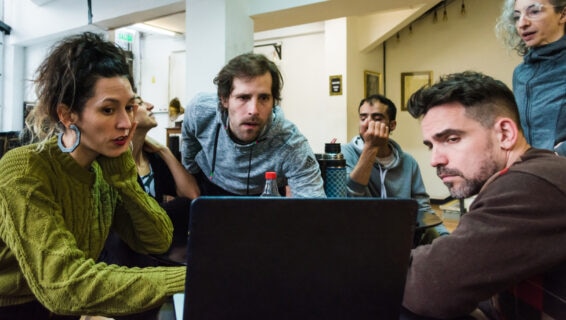
Teamwork and collaboration: How to foster both in the workplace
Table of Contents
- Importance of teamwork
- Creating a collaborative workplace
- Team building strategies
- Overcoming challenges
- Foster teamwork for lasting success
Organisations are only as successful as the teams that keep them running, so fostering a culture of strong teamwork and collaboration is vital to long term success.
From improved employee engagement and happiness, to increased productivity and results, having everyone pull in the same direction can be the difference between progress and stagnation.
In this article, we look at why teamwork is such an important thing to promote within your organisation and explore some strategies you can use to encourage it.
The importance of team building and collaboration
A strong culture of teamwork and collaboration is more important than ever in today’s world of work. As the Chartered Institute of Personnel and Development (CIPD) points out, people working together towards a common goal “often go above and beyond their individual responsibilities to achieve great things”, whereas “a poorly functioning team may result in conflict and dysfunction”.
In its recent evidence review of high-performing teams, the CIPD explained how team dynamics are vital for performance, building trust between team members, increasing psychological safety, and benefiting team cohesion.
And given the fierce competition for talent, relying on that one superstar hire to drive your organisation forward is a risky strategy, especially when creating a culture of teamwork and collaboration can deliver results greater than the sum of your organisation’s parts.
The benefits of team building and collaboration
There are a variety of advantages associated with having strong levels of teamwork and collaboration within your organisation. Let’s take a look at some of the core benefits:
- Improved productivity and efficiency: By emphasising teamwork, teams can harness the strengths of each member and the organisation will see more productive work with less wasted time.
- Better communication: A key facet of teamwork is communication. Teams that communicate better know what each part of the team is up to, meaning work can be streamlined and aligned.
- Shared responsibility: Teams that work well together take ownership of their responsibilities, their successes, and their failures. Good teamwork means colleagues will feel comfortable observing each other’s work and sharing feedback, in many cases bypassing the need for managerial intervention.
- Enhanced job satisfaction: A working environment with strong levels of teamwork and collaboration is often a happier workplace. A collaborative, supportive workplace can relieve stress, boost engagement levels, and increase motivation.
- Innovation: This is often about thinking about different approaches to problem solving. Having a team of brains working on a problem, rather than just one, facilitates the sharing of ideas and means different perspectives and experiences can be combined to generate innovative solutions.
- Working relationships: Colleagues who work closely together on challenges will form stronger professional bonds, which increase levels of trust and collaboration across teams.
- Recruitment and retention: If your workplace is known for fostering a strong sense of teamwork and collaboration, you’ll be able to attract strong candidates who want to work in that sort of atmosphere. You will also be able to retain staff for longer, as a result of increased staff happiness and job satisfaction.
- Cross-generational insight:Collaboration across generations encourages knowledge sharing between seasoned experts and newer, digitally native team members – boosting innovation and mutual learning. For more guidance on managing a multigenerational workforce effectively, see The multigenerational workforce: Benefits, challenges and best practices
Creating a collaborative workplace culture
Now we’ve seen the importance and benefits of a collaborative workplace culture, but how do you build one within your organisation? Let’s take a look.
Set clear goals
As with any other workplace strategy, it’s useful to establish clear and measurable goals before starting out. The most popular way of doing this is with the SMART method, making sure the goals are specific, measurable, achievable, realistic, and timely.
Come up with a collaboration strategy
With your goals set out it’s easier to come up with a collaboration strategy. This is about how you are going to achieve your goals, perhaps through team bonding activities, or by leveraging collaborative leaders to infuse teams with a sense of teamwork and collaboration.
Remember, whenever possible, look to align your strategy with the wider organisational goals.
Lead by example
Leaders have a big influence on company culture, which is why promoting and hiring leaders who have the qualities needed to foster teamwork throughout your organisation is so vital. According to the Society for Human Resource Management, leaders should look to establish teams that:
- Align behind a common goal
- Clarify each team member’s role
- Agree on the process
- Establish a code of conduct
Encourage cross-functional and generational collaboration
Collaboration across departments can break down silos, improve communication, and help individuals understand the bigger picture. It’s also a great way to upskill staff, share knowledge, and foster innovation.
At the same time, encouraging collaboration across age groups helps teams draw on the strengths of a multigenerational workforce – combining the fresh perspectives of younger employees with the experience and insight of older colleagues.

Reading tip
The multigenerational workforce: Benefits, challenges and best practices
Recognise and reward collaborative efforts
Recognition is vital for reinforcing behaviours you want to see in the workplace, so rewarding strong teamwork and collaborative efforts is a must. This could be in the form of a shared reward, perhaps a monetary one or paid time off for a team-building activity.
Team building strategies
In its evidence review of high-performing teams, the CIPD revealed the top interventions that can be used to build team effectiveness. These included team building exercises, which can result in increased trust, social cohesion, and internal communication, as well as improved team performance.
As one of the keyways to improve teamwork without stretching the budget too much, it’s worth thinking of some team building exercises that work for your organisation. Here are some ideas.
In-person team building
In-person team building is a common and popular way to improve relationships between team members. Usually targeting the more social, personal side of teams, it’s a chance to take the team out of the office and into a new environment. Team building is especially effective when:
- The person who plans it is external to the team
- Team members are not involved in planning
- It’s jointly led by an internal and an external colleague
- The focus is on the group, rather than on individuals
- The focus is on both team goals and interpersonal relations
Here are some in-person team building ideas you can use as inspiration:
- Escape rooms: These games rely on teamwork to solve clues and make the escape.
- Cooking classes: This is a fun and creative way for staff to get to know each other better – and the results could be delicious!
- Getting physical outdoors: If you have an active workforce, they might enjoy taking part in events like Tough Mudder, which are physically challenging but also instil a sense of camaraderie and teamwork in participants. For a more entry level activity you could organise a short hike outdoors.
Virtual team building
While the last few years have seen the rise of remote and hybrid work, that’s no excuse for forgetting team building activities. In fact, for remote team members it could be even more important for building a sense of belonging with the company.
There are plenty of virtual team building options organisations can implement, including:
- Virtual escape room: This can be done remotely as well as in-person, giving teams a real chance to work together, promoting collaboration to solve a common goal.
- Team building quiz: Quizzes are popular, and these days there are endless options for organising them digitally. It’s a great way to work on communication skills and integrate newer team members.
- Virtual cocktail making classes: The ingredients can be sent to workers’ homes and they can all participate in the online class led by an expert bartender.
Overcoming challenges
While there are numerous benefits to fostering a culture of teamwork and collaboration, it’s important to acknowledge that there are still challenges that need to be overcome in order to make this a reality in the workplace. Let’s take a look at some of these in more detail.
Conflicts and disagreements
Within any team, addressing conflict and disagreements is paramount to sustaining a harmonious working environment. The key lies in early intervention to prevent issues from escalating into more significant problems. Proactively engaging with these challenges begins by investing time in understanding team members and their unique working styles.
By gaining deeper insights into your colleagues, you can discern their motivations and better comprehend how they contribute to the team’s dynamics. This understanding significantly reduces the likelihood of conflicts arising. Moreover, promptly addressing any signs of inappropriate behaviour, such as bullying, sends a resolute message that such conduct will not be tolerated.
Leading by example is equally critical. Encouraging open and transparent communication within the team ensures that issues are openly discussed, underscoring the importance of dialogue in conflict resolution while maintaining a positive and cohesive team dynamic.
Remote issues
Remote work presents specific challenges, notably the risk of isolation and disengagement among team members. To counteract this, establishing clear and robust communication is imperative. Virtual huddles form an essential tool to maintain team connectivity, monitor workflow progress, and sustain the crucial human connection that can be lost in remote settings.
Furthermore, maintaining regular one-to-one meetings and team gatherings provides a sense of structure and continuity in the remote work landscape. To enhance communication further, ensure that team members are well-informed about the availability and accessibility of their managers and their colleagues by implementing a virtual open-door policy.
This approach fosters an atmosphere of accessibility and encourages remote workers to readily seek support or engage with their team whenever necessary, ultimately promoting a more seamless and productive remote work experience.
Foster a culture of teamwork and collaboration for prolonged success
In the ever-evolving world of work, where remote and hybrid arrangements have become the norm, it’s crucial for organisations to recognise that success still hinges on the collective strength of their teams. As a result, continually working to cultivate a robust culture of collaboration and teamwork is more essential than ever.
By charting and adhering to well-defined roadmap, organisations can sustain unified and collaborative teams that consistently contribute positively towards its specific goals and objectives. This commitment requires:
- Active promotion of cross-functional collaboration
- Recognising and rewarding collaborative efforts
- Wholeheartedly embracing physical and virtual team building
However, organisations must remain vigilant and proactive. Challenges and conflicts may arise, and it’s vital to address them openly and adapt strategies as needed. By doing so, it’s possible to ensure that teams not only remain harmonious but also resilient, adapting to the dynamic nature of the modern workplace.
Receive the latest recruitment resources and
advice to boost your hiring
By providing us with your details you agree to our privacy policy and for us to keep you updated with the latest news, events,
and special offers from Totaljobs.






